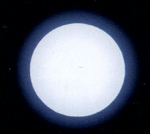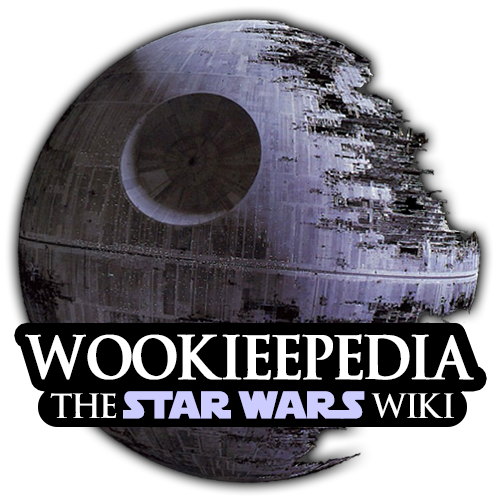| | |
- "When the night it is… is the sun gone?"
"I mean… of course it's not."
"Of course. Obvious, it is." - ―Yoda uses a sun as an allegory for the Force to Luke Skywalker

A star being drained to power the Starkiller Base superweapon.
Stars were massive, glowing, spheres of plasma and gas that produced their own light and energy. Stars that were the central body of a planetary system were referred to as suns.
Description[]

The star Kessa
Stars were large celestial bodies that generated heat, light and radiation and consisted[2] of a core of helium and hydrogen gas burning in plasma form. Due to the high temperatures, the star underwent nuclear fusion, creating a temperature of around 5,500 degrees on its inner surface, known as the "photosphere". Surrounding the photosphere was the "chromosphere", a cooler, gaseous layer which gave the star its particular color. At the edge of a star's surface was the corona, comprised of rarefied gas.[3]
During the High Republic Era, stars were assigned to a specific class by their chemical properties, such as R-class stars being unusually nitrogen-heavy.[4] A human's skin could darken from sun exposure; Sergeant Tonra usually had a pale complexion, but after spending two weeks in the sun, his skin reddened significantly. Human infants needed to be protected from the sun; when Sola Naberrie was preparing to spend the day outdoors with her newborn baby Ryoo, she needed to get Ryoo's sun protection first.[5] Plants also drew sustenance from sunlight.[6]
Types of stars[]
There were seven types of main sequence stars in the galaxy:[3]
- "A" stars were white, and had a lifespan of four hundred million to two billion years. Example: Colu.[3]
- "M" stars were red and emitted little light or heat. They had a lifespan of over one hundred trillion years. They were also called red dwarfs. Example: Barab.[3]
With O-class stars being the biggest in the sequence, the size decreased gradually to the smallest M-class stars.[3]
The non-main sequence stars include:[3]
Pre-main sequence (smaller than M-class stars):[3]
- Brown dwarf. Example: Doornik-1142.[3]
- Protostar. Example: Black Bantha Nebula.[3]
Post main-sequence (bigger than O-class stars):[3]
- Red giant. Example: Sokor.[3]
- Blue giant. Example: Ku'Baku.[3]
- Red supergiant. Example: Primus Goluud.[3]
Compact stars:[3]
- White dwarf. Example: Ardos.[3]
- Black dwarf. Example: A star in the The Ring.[3]
- Neutron star. Example: Oolex pulsar.[3]
- Black hole. Example: Endor Gate.[3]
Other exotic star types existed that did not fit precisely into this system of classification. These included Asar, considered a blue dwarf,[7] and yellow dwarfs.[8]
Life cycle[]
- "The strongest stars have hearts of kyber."
- ―Chirrut Îmwe
Birth[]
Stars formed in areas of space known as stellar nurseries,[10] through a collision of energies in the form of pressure and heat, a process which shaped the space around it and could be seen from millions of kilometers away.[11] The collapse of a nebula[3] or the ignition of a planet's core by an outside force could also result in the formation of a star.[12] Chirrut Îmwe once remarked that the "strongest stars" had kyber at their center.[9] During their formation, which took millions of years, stars were identified as either protostars or brown dwarfs, the latter being too small to maintain a hydrogen fusion reaction and died out.[3]
Stars and planets[]

A field of stars
- "There are so many! Do they all have a system of planets?"
"Most of them." - ―Anakin Skywalker and Jedi Master Qui-Gon Jinn, looking at the stars
After reaching their full size, stars often started expelling clouds of gas and dust, which formed into a set of planets[3] and other bodies.[13] In that case, the stars were referred to as suns. A sun, together with all the bodies bound to it, formed a planetary system. In some cases, a planetary system could contain several suns, as was the case around the planets of Tatooine[14] and Mon Cala.[15] Life could not exist without stars.[16]
A planet revolving around a star normally received light and warmth from it,[8] although there were exceptions. Umbara was known as the "Shadow World" because the rays of its sun never completely reached the planet's surface, keeping it in perpetual darkness.[17] In the night sky, remote stars looked like mere points of light.[13] By convention, those points of light were grouped into constellations.[18] Without a star, most worlds would become lifeless and frozen. The size and distance of a sun would affect many of the features of a planet orbiting it.[19]
On the planet Coruscant, stars were hard to see, due to all the city lights of the sprawling ecumenopolis. However, according to young Obi-Wan Kenobi, one could see them if they knew how to look. Stars could be used for navigation: When young Kenobi returned to the Jedi Temple after trying to help fellow Jedi Initiate Gehren Rand, who had run away, he used the stars to find his way home.[20]
Death[]
After passing through the main sequence, the fusion reactions inside a star slowly stopped and they expanded in size, turning into blue or red giants. Immediately before the fusion reactions completely stopped, the stars turned into red supergiants, which soon collapsed in on themselves in an explosion known as a supernova. Exploding stars then turned into either a highly radioactive neutron star or, of the star was particularly large, a singularity inside a black hole. Small to medium-sized stars turned into white dwarfs, which after billions of years died out into black dwarfs.[3]
Stars in culture[]
- "I belong to the stars."
"You're owned by giant balls of exploding gas?"
"Okay... Maybe I'm over-romanticizing it a bit." - ―Poe Dameron and Karé Kun
Resistance member Karé Kun once referred to stars as "giant balls of exploding gas."[21] Prime Minister Dreand Yens once remarked that stars only twinkled in the sky because they were burning to stay alive, which he believed was proof that nature's beauty came from function.[22]
Appearances[]
Non-canon appearances[]
- ° LEGO Star Wars: The Freemaker Adventures
- LEGO Star Wars: The Force Awakens
 Star Wars: Jedi Temple Challenge — "Episode 2" (Mentioned only) (In flashback(s))
Star Wars: Jedi Temple Challenge — "Episode 2" (Mentioned only) (In flashback(s)) Star Wars: Jedi Temple Challenge — "Episode 3"
Star Wars: Jedi Temple Challenge — "Episode 3" Star Wars: Visions — "The Elder"
Star Wars: Visions — "The Elder"- LEGO Star Wars: The Skywalker Saga
- "The Elder" — Big Gangan Vol.06
 Star Wars: Visions — "In the Stars"
Star Wars: Visions — "In the Stars" Star Wars: Visions — "Journey to the Dark Head"
Star Wars: Visions — "Journey to the Dark Head"
Sources[]
Notes and references[]
- ↑ Star Wars (2020) 35
- ↑ Star Wars: Absolutely Everything You Need to Know
- ↑ 3.00 3.01 3.02 3.03 3.04 3.05 3.06 3.07 3.08 3.09 3.10 3.11 3.12 3.13 3.14 3.15 3.16 3.17 3.18 3.19 3.20 3.21 3.22 3.23 3.24 3.25 3.26
 Star Wars: Build the Millennium Falcon 34 (Guide to the Galaxy: Types of Stars)
Star Wars: Build the Millennium Falcon 34 (Guide to the Galaxy: Types of Stars)
- ↑ The High Republic: Light of the Jedi
- ↑ Queen's Shadow
- ↑ Star Wars: The Rise of Skywalker: The Visual Dictionary
- ↑ Nexus of Power
- ↑ 8.0 8.1 Bloodline
- ↑ 9.0 9.1 Rogue One: A Star Wars Story
- ↑ Star Wars: Aliens of the Galaxy
- ↑ A New Hope: The Princess, the Scoundrel, and the Farm Boy
- ↑ Star Wars: The Force Awakens novelization
- ↑ 13.0 13.1 13.2 Star Wars: Episode I The Phantom Menace
- ↑
 Tatooine in the Databank (backup link)
Tatooine in the Databank (backup link)
- ↑
 Mon Cala in the Databank (backup link)
Mon Cala in the Databank (backup link)
- ↑
 "Forces of Nature: The Wild Spaces and Wilder Creatures of the Star Wars Galaxy" — Star Wars Insider 216
"Forces of Nature: The Wild Spaces and Wilder Creatures of the Star Wars Galaxy" — Star Wars Insider 216
- ↑
 Umbara in the Databank (backup link)
Umbara in the Databank (backup link)
- ↑ Star Wars Rebels: Ezra's Duel with Danger
- ↑ Star Wars: The Visual Encyclopedia
- ↑ Obi-Wan 1
- ↑ 21.0 21.1 Age of Resistance - Poe Dameron 1
- ↑ The Princess and the Scoundrel

